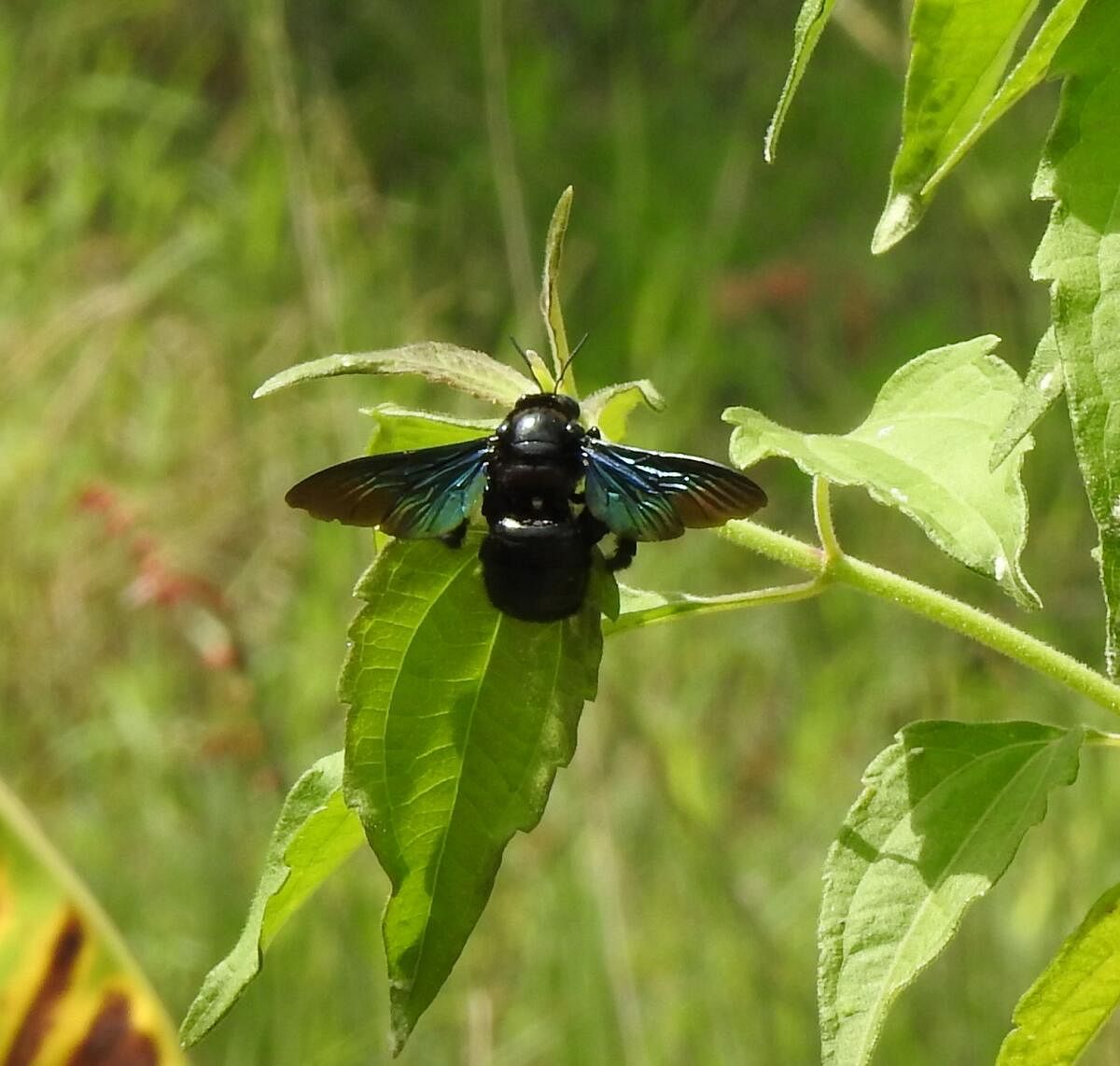
I watched transfixed as the sea of yellow and green swayed and eddied to the lilt of the wind. We had planted Sunn Hemp (Crotalaria juncea) at the onset of the monsoon to suppress invasive weeds and nourish and fix atmospheric nitrogen in the soil. A few months later, Navilu Kaadu was enrobed in canary yellow Sunn Hemp blossoms.
Soon the wavy floral blanket lay still, as the wind tired of the tango. I waited. The wind would surely return seeking another dance? Instead, a dozen unexpected suitors waltzed in, glossy and iridescent.
The newest paramours were kitted out nattily with rainbow wings and armours of burnished ebony. Plum-sized tropical carpenter bees (Xylocopa latipes) buzzed and quivered, serenading the flowers. Tropical carpenter bees are among the largest bees in the world and probably the largest among all carpenter bee species of the genus Xylocopa. They are solitary, like the leafcutter bees in my previous column, though mother and daughter bees are known to live socially.
Solitary bee species form the biggest group among the 20,000-odd bee species in the world, outnumbering honeybee species (just eight worldwide) by a wide margin. They neither build hives nor make honey, but are important pollinators of crops like lentils, tomatoes, brinjal and other vegetables and fruits.
Carpenter bees get their name from their habit of burrowing inside dead wood and bamboo. Female carpenter bees use powerful mandibles to drill half-inch circular holes into wood. Unlike termites, these bees don’t devour wood. Instead, they painstakingly tunnel through wood and create nests with four to six brood cells.
And like their cousins, the leafcutter bees, female carpenter bees stock each cell with ‘bee bread’ made from pollen and nectar and lay a single egg on the pollen loaf. They then seal the cell with regurgitated wood. The eggs of carpenter bees are around 15 mm long and are said to be among the largest eggs of all insects, relative to the size of the egg-laying female.
Tropical carpenter bees are multivoltine, which means they can have more than two broods a year if they have access to floral resources.
Mature bees emerge in seven weeks after completing the egg, larval and pupal phases in seven weeks. Male bees are stingless yet territorial. Females wield stings but do not attack unless they perceive a threat to their nests. These bees forage for nectar and pollen and have lifespans between one and three years.
Bee-eaters, shrikes, kingfishers and large insects such as praying mantises and robber flies prey on carpenter bees. I suspect the black-rumped flameback woodpeckers that hammer away at the trunk of our dried-up Shami tree could be prying out fat, juicy grubs from carpenter bee nests! These bees are buzz pollinators and use ‘sonification’, vibrating their thoracic muscles, to dislodge pollen grains from the flower’s anthers. They are hence nicknamed live tuning forks. Besides Sunn Hemp, I’ve spotted these bees around flowers of the giant milkweed plant (Yekka in Kannada) and Gliricidia sepum, a small-sized tree, another great nitrogen fixer.
Sadly, wild bee populations face unprecedented threats and humans are paying the price already for snuffing out insect pollinators.
According to a new study published in Environmental Health Perspectives, “half a million people are currently dying prematurely every year due to global insect pollinator decline, because of its impact on availability and price of healthy foods such as nuts, legumes, fruits and vegetables.” It identifies areas including India, Russia, China, and parts of Southeast Asia as “suffering a greater loss of the protective effect from consumption of pollinator-dependent foods.”
The study attributes the insect pollinator decline primarily to shrinking habitats. Monocropping farming practices and frequent soil tilling have destroyed wild flora, critical for pollinator nesting. Indiscriminate use of pesticides and fungicides has further decimated wild bee populations.
While one can argue that managed honeybees may well accomplish the work of wild bees, research reveals domesticated bees cannot stand in for their wild cousins nor replicate their pollination prowess.
How can we avert this mounting catastrophe? Scientists suggest retaining small foraging patches of native wild flora on farms and along hedgerows and limiting pesticide use. We city folk can plant native flowering species in our urban gardens and leave dead, woody plant stems standing, as ‘bee hotels’ or nesting sites.
At Navilu Kaadu, our weed-averse neighbours frequently give us an earful on ‘de-weeding’ our overgrown farm. No sir, we wouldn’t trade our fecund wild patch for manicured barrenness!
Rooting For Nature is a monthly column on an off-kilter urban family’s trysts with nature on a natural farm.
The author chipped away at a software marketing career before shifting gears to independent consulting and natural farming. She posts as @ramyacoushik on Instagram. Reach her at bluejaydiaries@gmail.com